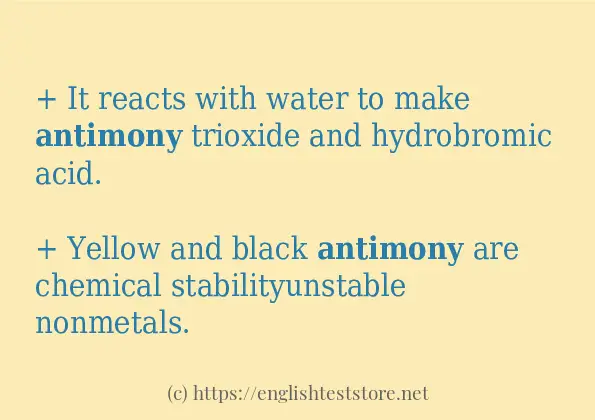How to use in-sentence of “antimony”:
+ It reacts with water to make antimony trioxide and hydrobromic acid.
+ Yellow and black antimony are chemical stabilityunstable nonmetals.
+ It burns in air to make antimony oxide and sulfur dioxide.
+ It burns very easily in air to make antimony trioxide and water.
+ Antimony trioxide, also known as antimony oxide, is a chemical compound.
+ Antimony pentafluoride, also known as antimony fluoride, is a chemical compound.
+ Antimony trisulfide is made in the laboratory by reacting any antimony compound with hydrogen sulfide.
+ It can also be made by reacting antimony pentafluoride or antimony pentachloride with water.

Example sentences of “antimony”:
+ It has antimony and sulfide ions in it.
+ A Belgian chemist reacted a chloride with antimony trifluoride and chlorine to make a fluoride from the chloride.
+ The antimony is in its +5 oxidation state.
+ They are the most common antimony compounds.
+ Antimony burns in air to make antimony trioxide.
+ This alloy, 5% antimony and 95% lead, is harder than pure lead.
+ The first time antimony was mentioned in Europe was in the 1540.
+ The common allotrope of antimony is a blue-white metalloid.
+ Antimony trisulfide, also known as antimony sulfide, is a chemical compound.
+ Some antimony compounds were used as medicines to kill protozoans.
+ They are made by reacting antimony with other metals.
+ It has antimony and sulfide ions in it.
+ A Belgian chemist reacted a chloride with antimony trifluoride and chlorine to make a fluoride from the chloride.
+ The antimony is in its +5 oxidation state.
More in-sentence examples of “antimony”:
+ It reacts with oxidizing agents to make antimony pentoxide and with reducing agents to make antimony or stibine.
+ There is another explosive form of antimony that is made by electrolysis of antimony trichloride.
+ About half of all antimony is used to make antimony trioxide for flame proofing.
+ Breathing in antimony dust can be very dangerous.
+ When antimony is talked about it normally means the blue-white metalloid form, since it is most common.
+ Antimony trioxide is made when antimony is made.
+ It is made by reacting antimony trioxide with nitric acid.
+ This cation is also made when iodine reacts with antimony pentafluoride.
+ Stibnite is heated with air to make antimony trioxide.
+ It turns into black antimony when light is shined on it or when it is warmer.
+ It can also be made by reacting antimony trifluoride with fluorine.
+ It is made by reacting antimony pentoxide or antimony pentachloride with hydrofluoric acid.
+ It breaks down to antimony tetroxide when heated to a high temperature.
+ It reacts with hydrochloric acid and hydrofluoric acid to make antimony pentachloride and antimony pentafluoride.
+ This makes antimony trioxide.
+ Yellow antimony is only found at very cold temperatures.
+ Tin can be hardened by adding antimony or copper, as well as some other elements.
+ Sometimes, antimony was put in them to make them harder.
+ Stibnite is burned in air with calcium chloride to make calcium sulfate and antimony trichloride, which is reacted with water to make antimony trioxide.
+ Other countries that make antimony are South Africa, Bolivia, and Kyrgyzstan.
+ It is made by heating antimony trioxide with air, burning antimony in air, or heated antimony pentoxide strongly.
+ It is made by reacting antimony with iodine or by reacting concentrated hydriodic acid with antimony trioxide.
+ This antimony explodes when changing into the metallic form.
+ It reacts with water to make antimony trioxide and hydrochloric acid or hydrogen chloride.
+ It is made by reacting liquid antimony trichloride with chlorine.
+ It reacts with oxidizing agents to make antimony pentoxide and with reducing agents to make antimony or stibine.
+ There is another explosive form of antimony that is made by electrolysis of antimony trichloride.
+ About half of all antimony is used to make antimony trioxide for flame proofing.
+ Antimony pentafluoride is highly reactive, as well as antimony pentoxide.
+ Stibine can also be made by reacting any antimony compound such as antimony trioxide with any hydride.
+ Pewter has antimony in it.
+ It is separated from arsenic by the boiling of the arsenic trioxide before the antimony trioxide boils.
+ Antimony trifluoride, also known as antimony fluoride or Swart’s reagent, is a chemical compound.
+ Antimony tetroxide has antimony in both its +3 and +5 oxidation state.
+ It has antimony in its +3 oxidation state.
+ The stibine is heated and a shiny area of antimony is made in the heated part of the tube.
+ Stibine easily decomposes into antimony and hydrogen at room temperature.
+ Stibnite is the mineral form of antimony trisulfide.
+ When small amounts of other elements like antimony are added, the tin cannot change into alpha-tin.
+ Among its mineral reserves are solid amount of coal, gold, uranium, antimony and other metals but not iron.
+ Some pigments have antimony in them.
+ It is made by reacting chlorine with antimony, antimony trioxide, or antimony trisulfide.
+ It dissolves in hydrochloric acid to produce tin chloride, leaving the antimony and copper behind in the hydrochloric acid.
+ It reacts with hydrochloric acid to make hydrogen sulfide and an antimony compound.
+ It is made by reacting antimony trioxide with concentrated hydrofluoric acid or by reacting antimony with a little fluorine.
+ It has antimony and fluoride ions in it.
+ It reacts with concentrated acids to make antimony salts and dissolves in strong bases.
+ In excess air, it burns to antimony tetroxide.
+ Sometimes germanium and antimony are included, although they are normally considered metalloids.
+ The antimony trioxide gas is condensed in a container.
+ It is the most common antimony compound.
